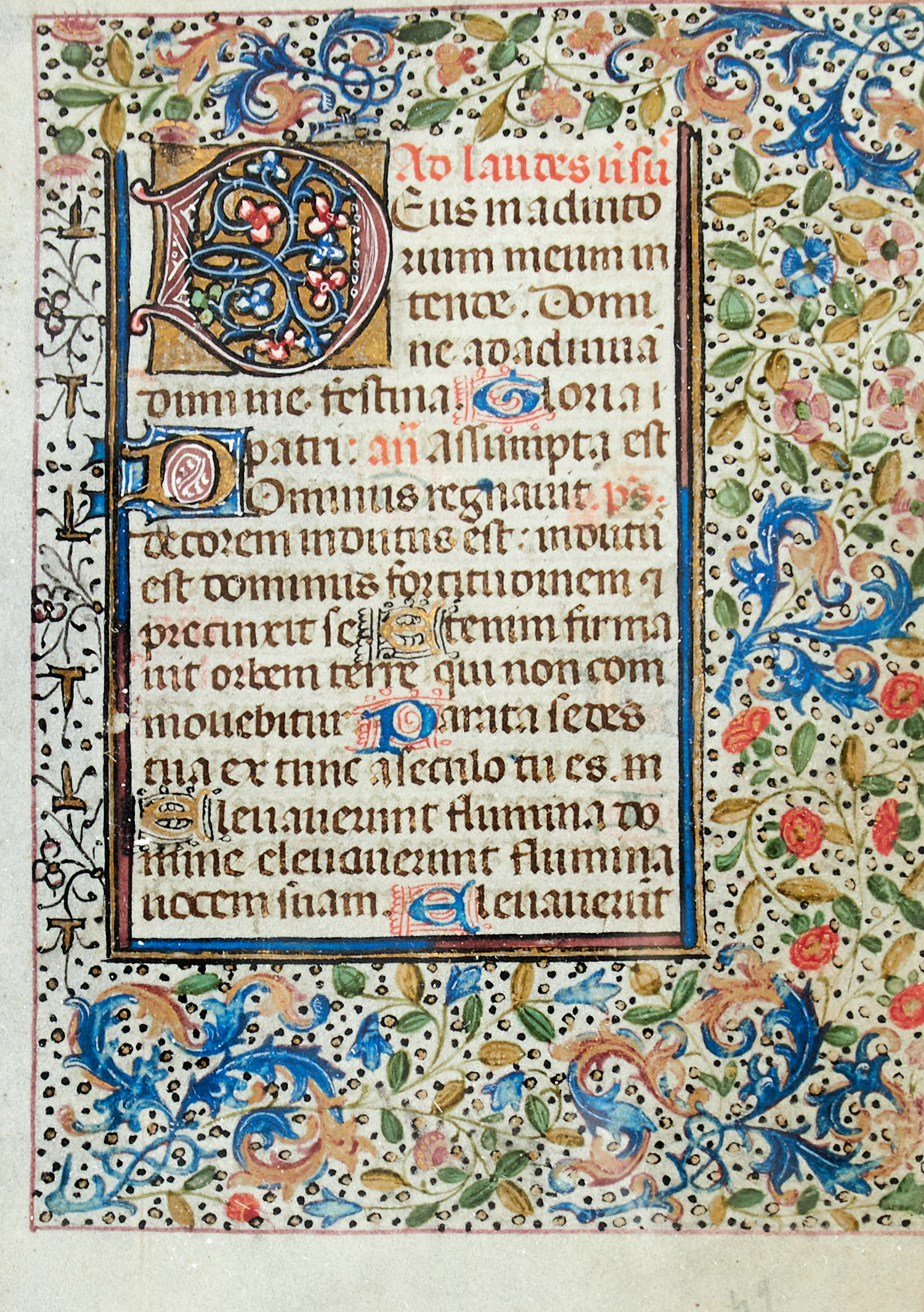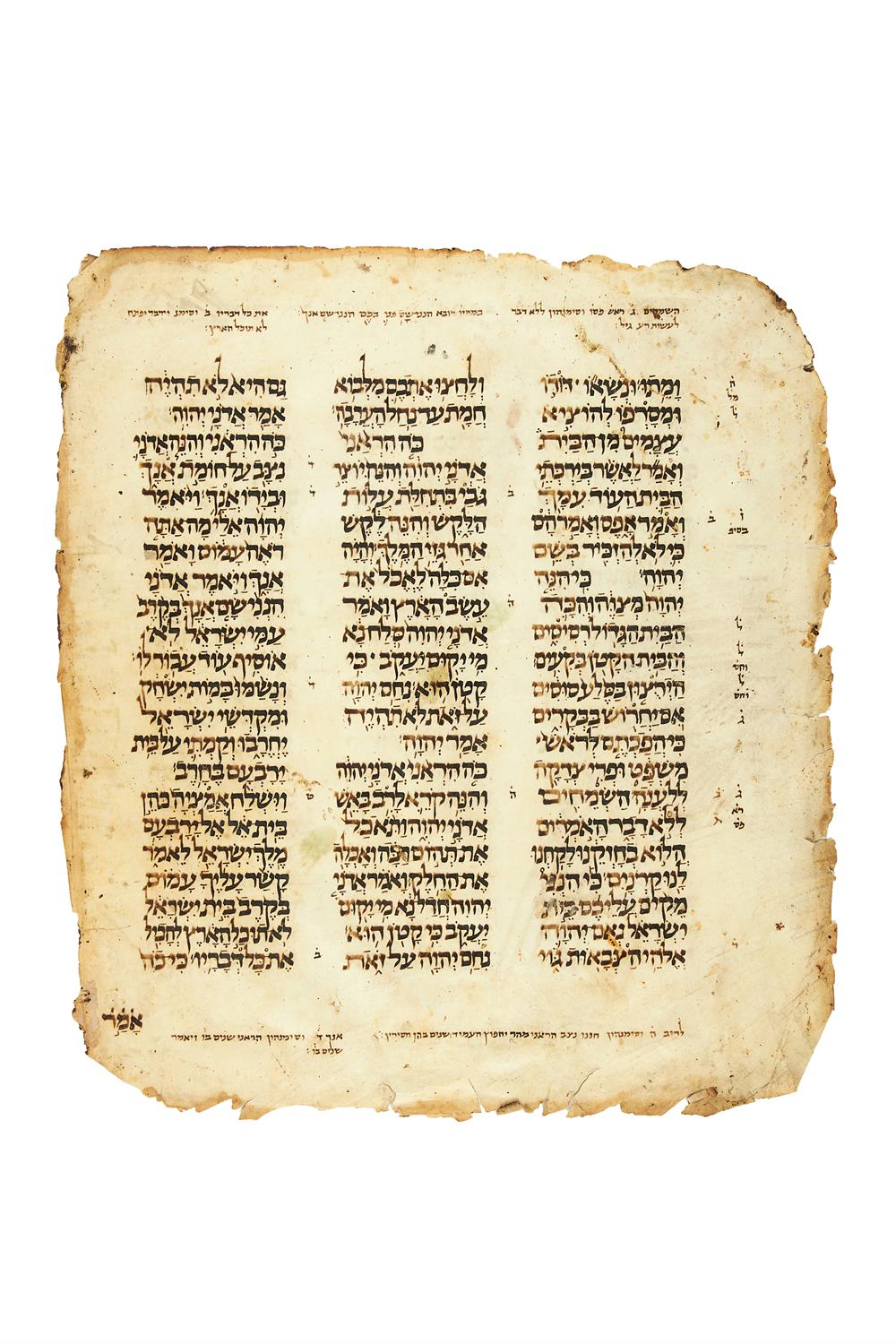BIBLE with Masorah, in Hebrew, MANUSCRIPT ON VELLUM Ocaña, Spain, 1491 and Evora, Portugal, 1494 328 x 270mm. Two volumes bound in four: I, 270 leaves, 1 4, 2-34 8, 35 2(of 8, iii-viii opening vol.II); II, 182 leaves, 1 6(of 8, i and ii ending vol.I), 2-16 8, 17 6, 18-22 8, 23 6, 24 4; III, 184 leaves, 1 4, 2-6 8, 7 6, 8-23 8, 24 6(of 8, vii and viii opening vol.IV); IV, 193 leaves, 1 2(of 8, i-vi ending vol.III), 2-24 8, 25 3(of 4, iv cancelled blank), 26 4, COMPLETE, mostly two columns of 21 lines written in brown ink in a Sephardic Hebrew square script with nikud, Masoretic notes and colophons without nikud, below 21 horizontals and between pairs of outer verticals and three central verticals ruled in blind, justification: approx. 195mm x 70-30-70, some sections with hymns or songs decoratively laid out in subdivided columns or in long and short lines, the Song of the Sea written space-under-script and script-under-space, Masorah Magna and Parva written in a small square hand in upper and lower margins and beside the columns, sometimes in a decorative zig-zag layout, Masoretic notes in four columns of script framed within a square of script, occasional marginal or intercolumnar flourishing (stain in outer margin of first 12 leaves of vol.III touching outermost letters of 2-3 lines of text on 7 leaves, without affecting legibility, repair to this area on eight leaves, small stains and repairs to outer margin of final two leaves of vol.IV). English 19th-century purple straight-grained morocco gilt with the arms and monogram of Theodore Williams in the centre of upper and lower covers, strapwork-patterned gilt doublures, edges gilt and gauffered (very slight scuffing at some corners). A HANDSOME AND COMPLETE FOLIO BIBLE: AN ELOQUENT WITNESS OF THE TURBULENT FATE OF THE SEPHARDIC JEWS PROVENANCE: 1. Abraham ben Jacob ben Zadok: he is named by the scribe, Isaac bar Ishai ben Sason, in the colophons at the end of volumes II and IV as the person for whom the manuscript was made. Beyond identifying the scribe and patron of the Bible these colophons reveal the extraordinary circumstances of its production. It was originally written as two discrete volumes, the Prophets (now volumes III and IV) was completed 9 Elul 5251 (1491) in Ocaña, Castile. The Pentateuch and Writings (now volumes I and II) were completed 2 Kislev 5255 (1494) in Evora in the Kingdom of Portugal. Isaac bar Ishai points out that this was two years after the expulsion of the Jews from Castile. The majority of Spanish Jews, like Isaac and his patron, moved to Portugal where King João II allowed their entry. But their security was illusory and, only two years after the completion of the Bible, a new king issued the 5 December 1496 edict expelling all Jews from that kingdom too. 2. Convent of the Discalced Carmelites S. Paolo, Florence: the manuscript, still bound as two volumes, was seen here by Benjamin Kennicott, who included it as Nos 520 and 521 in his Dissertatio Generalis in Vetus Testamentum (1780), bound with the Vetus Testamentum Hebraicum (Oxford, 1776). This location was also given by Giovanni Bernardo de Rossi when -- remarking on its excellent condition -- he made fuller transcriptions of the colophons: Variae Lectiones Veteris Testamenti , (Parma, 1784), vol.I, p.86. The library of the Convento della Conversione di San Paolo was established in Florence around 1700 by Padre Ildefonso, a member of the Accademia della Crusca. It was sacked by the Napoleonic forces and what books remain from it are now relocated to the theological college of San Matteo in Arcetri. 3. ?Andoche Junot, duc d'Abrantès (1771-1813). The 1827 sale catalogue informs that the 'Bible was deemed one of the finest Hebrew manuscripts of the Vatican, and reckoned the finest in existence. Junot, when Governor of Rome, laid his vandal hands on it, and deprived that noble library of one of its greatest treasures'. The Bible appears in neither the 1816 nor the 1817 sale catalogues of b
BIBLE with Masorah, in Hebrew, MANUSCRIPT ON VELLUM Ocaña, Spain, 1491 and Evora, Portugal, 1494 328 x 270mm. Two volumes bound in four: I, 270 leaves, 1 4, 2-34 8, 35 2(of 8, iii-viii opening vol.II); II, 182 leaves, 1 6(of 8, i and ii ending vol.I), 2-16 8, 17 6, 18-22 8, 23 6, 24 4; III, 184 leaves, 1 4, 2-6 8, 7 6, 8-23 8, 24 6(of 8, vii and viii opening vol.IV); IV, 193 leaves, 1 2(of 8, i-vi ending vol.III), 2-24 8, 25 3(of 4, iv cancelled blank), 26 4, COMPLETE, mostly two columns of 21 lines written in brown ink in a Sephardic Hebrew square script with nikud, Masoretic notes and colophons without nikud, below 21 horizontals and between pairs of outer verticals and three central verticals ruled in blind, justification: approx. 195mm x 70-30-70, some sections with hymns or songs decoratively laid out in subdivided columns or in long and short lines, the Song of the Sea written space-under-script and script-under-space, Masorah Magna and Parva written in a small square hand in upper and lower margins and beside the columns, sometimes in a decorative zig-zag layout, Masoretic notes in four columns of script framed within a square of script, occasional marginal or intercolumnar flourishing (stain in outer margin of first 12 leaves of vol.III touching outermost letters of 2-3 lines of text on 7 leaves, without affecting legibility, repair to this area on eight leaves, small stains and repairs to outer margin of final two leaves of vol.IV). English 19th-century purple straight-grained morocco gilt with the arms and monogram of Theodore Williams in the centre of upper and lower covers, strapwork-patterned gilt doublures, edges gilt and gauffered (very slight scuffing at some corners). A HANDSOME AND COMPLETE FOLIO BIBLE: AN ELOQUENT WITNESS OF THE TURBULENT FATE OF THE SEPHARDIC JEWS PROVENANCE: 1. Abraham ben Jacob ben Zadok: he is named by the scribe, Isaac bar Ishai ben Sason, in the colophons at the end of volumes II and IV as the person for whom the manuscript was made. Beyond identifying the scribe and patron of the Bible these colophons reveal the extraordinary circumstances of its production. It was originally written as two discrete volumes, the Prophets (now volumes III and IV) was completed 9 Elul 5251 (1491) in Ocaña, Castile. The Pentateuch and Writings (now volumes I and II) were completed 2 Kislev 5255 (1494) in Evora in the Kingdom of Portugal. Isaac bar Ishai points out that this was two years after the expulsion of the Jews from Castile. The majority of Spanish Jews, like Isaac and his patron, moved to Portugal where King João II allowed their entry. But their security was illusory and, only two years after the completion of the Bible, a new king issued the 5 December 1496 edict expelling all Jews from that kingdom too. 2. Convent of the Discalced Carmelites S. Paolo, Florence: the manuscript, still bound as two volumes, was seen here by Benjamin Kennicott, who included it as Nos 520 and 521 in his Dissertatio Generalis in Vetus Testamentum (1780), bound with the Vetus Testamentum Hebraicum (Oxford, 1776). This location was also given by Giovanni Bernardo de Rossi when -- remarking on its excellent condition -- he made fuller transcriptions of the colophons: Variae Lectiones Veteris Testamenti , (Parma, 1784), vol.I, p.86. The library of the Convento della Conversione di San Paolo was established in Florence around 1700 by Padre Ildefonso, a member of the Accademia della Crusca. It was sacked by the Napoleonic forces and what books remain from it are now relocated to the theological college of San Matteo in Arcetri. 3. ?Andoche Junot, duc d'Abrantès (1771-1813). The 1827 sale catalogue informs that the 'Bible was deemed one of the finest Hebrew manuscripts of the Vatican, and reckoned the finest in existence. Junot, when Governor of Rome, laid his vandal hands on it, and deprived that noble library of one of its greatest treasures'. The Bible appears in neither the 1816 nor the 1817 sale catalogues of b


.jpg)







Testen Sie LotSearch und seine Premium-Features 7 Tage - ohne Kosten!
Lassen Sie sich automatisch über neue Objekte in kommenden Auktionen benachrichtigen.
Suchauftrag anlegen